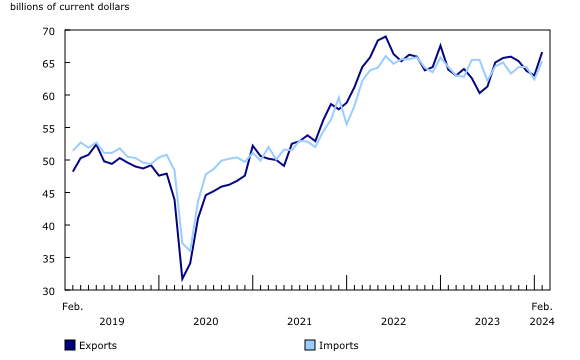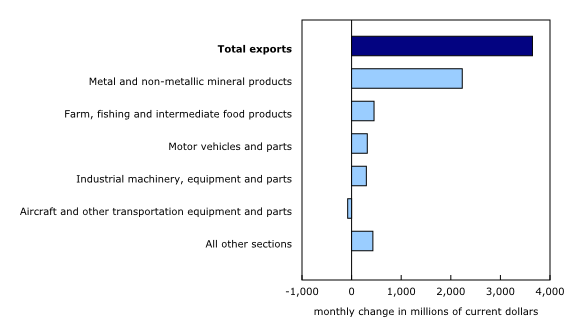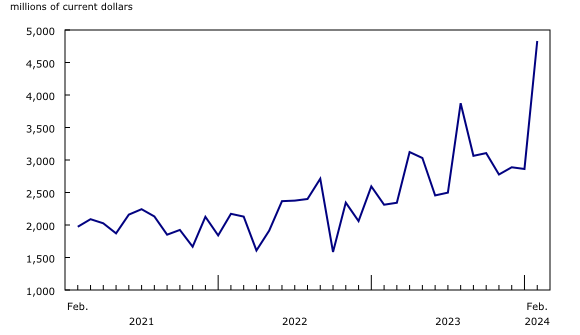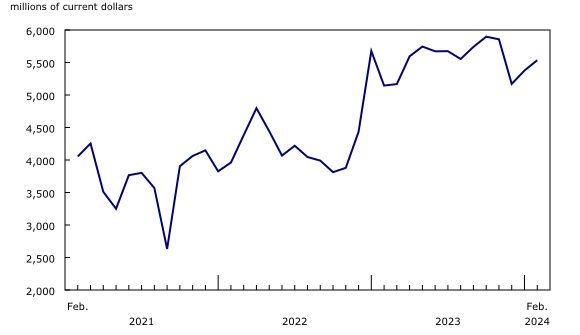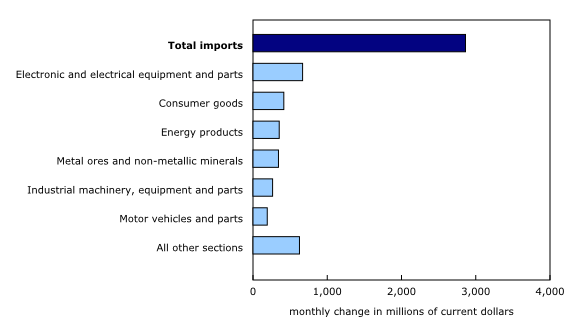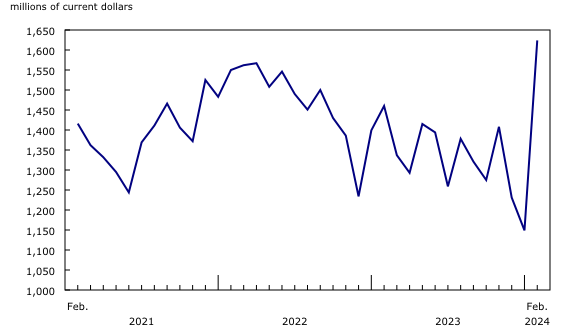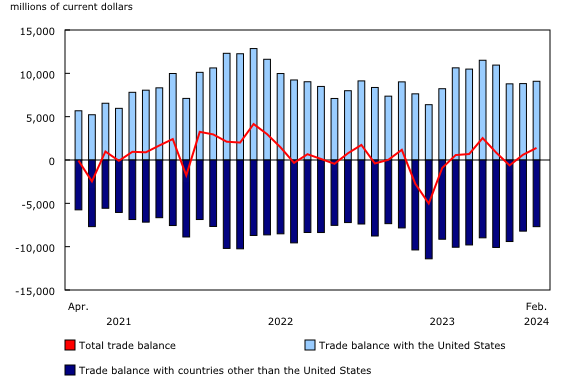Canadian international merchandise trade, February 2024
Released: 2024-04-04
In February, significant growth was observed in Canada's merchandise exports and imports. Exports increased 5.8%, while imports rose 4.6%. As a result, Canada's merchandise trade surplus with the world widened from $608 million in January to $1.4 billion in February.
Consult the "International trade monthly interactive dashboard" to explore the most recent results of Canada's international trade in an interactive format.
Gold exports post all-time high
Total exports were up 5.8% in February, the largest percentage increase since August 2023. Overall, increases were observed in 9 of the 11 product sections. In February 2024, more than half of the growth in total exports was driven by a sharp rise in exports of unwrought gold. Excluding the product group for unwrought gold, exports were up 2.8%. In real (or volume) terms, total exports rose 6.2% in February.
Exports of metal and non-metallic mineral products increased 31.1% in February to a record $9.4 billion. Exports of unwrought gold, silver, and platinum group metals and their alloys—a category largely composed of unwrought gold—contributed the most to the growth, posting a $2.0 billion or 68.8% increase. Increased high-value shipments of refined gold, as well as transfers of gold assets in the banking sector, were observed in February. This increase coincided with a sharp rise in the market price of gold at the end of February.
Exports of farm, fishing and intermediate food products rose 9.7% in February, the strongest percentage increase observed since July 2023. After falling 15.9% in January 2024, wheat exports (+27.0%) rebounded in February and contributed the most to the growth in this product section. Higher wheat shipments to Asian countries, especially to Bangladesh, were observed in February. Exports of other crop products (+12.9%) also contributed to the February increase, due in part to higher exports of barley to China.
Exports of motor vehicles and parts rose 3.8% in February. Exports of passenger cars and light trucks (+3.0%) posted the largest increase. Despite the gain, these exports were still more than 5% below the highs of October and November 2023, as retooling continued to limit motor vehicle production in Canada. The increase in exports of motor vehicle engines and parts (+5.4%) also contributed to the growth in this product section in February.
Imports reach their highest level since June 2023
After decreasing 3.1% in January, total imports were up 4.6% in February. All product sections rose, except metal and non-metallic mineral products, which fell slightly by 0.6%. Year over year, imports rose 1.4% in February. In real (or volume) terms, total imports increased 4.1% in February compared with the previous month.
Imports of electronic and electrical equipment and parts increased 9.7% to a record $7.6 billion in February. Imports of computers and computer peripherals (+41.4%), which had been trending downward since the spring of 2022, were mostly responsible for the growth in February 2024. The monthly increase in imports was led by imports of high-value data processing units (servers) from the United States. These units are generally used for the development of complex cloud systems.
Imports of consumer goods (+3.3%) were also up in February. The increase was widespread across subcategories for this product section. In total, 17 of the 20 product groups posted gains in February. Of these, imports of clothing, footwear and accessories (+6.5%) saw the largest increase.
Imports of energy products rose 10.2% in February. Crude oil imports, which were up 9.0%, contributed the most to the increase. This growth followed a 9.1% decrease in January. Imports of crude oil are mostly shipped via water, and the timing of a tanker's delivery of crude oil can result in strong fluctuations from one month to the next.
Canada's exports and imports with both the United States and other countries increase
Exports to countries other than the United States jumped 14.2% in February, driven mostly by a strong increase in unwrought gold exports to Switzerland and the United Kingdom. Meanwhile, imports from countries other than the United States rose 6.7%. The largest increases in imports were observed for China (various products), the United Kingdom (aircraft), Indonesia (scrap of non-ferrous metals) and South Korea (passenger cars and light trucks).
As a result, Canada's trade deficit with countries other than the United States narrowed from $8.2 billion in January to $7.7 billion in February.
Exports to the United States were up 3.3% in February, while imports from the United States increased 3.4%. As a result, Canada's trade surplus with the United States widened slightly from $8.8 billion in January to $9.1 billion in February.
Revisions to January merchandise export and import data
Imports in January, originally reported at $61.8 billion in the previous release, were revised to $62.4 billion in the current reference month's release. Exports in January, originally reported at $62.3 billion in the previous release, were revised to $63.0 billion in the current reference month's release.
Monthly trade in services
In February, monthly service exports were up 1.9% to $17.4 billion. Meanwhile, imports increased 0.8% to $18.4 billion.
When international trade in goods and services are combined, exports increased 5.0% to $84.0 billion in February, while imports gained 3.7% to $83.6 billion. As a result, Canada's total trade balance with the world went from a $595 million deficit in January to a surplus of $367 million in February.
Did you know we have a mobile app?
Get timely access to data right at your fingertips by downloading the StatsCAN app, available for free on the App Store and on Google Play.
Note to readers
Information on concepts and methods used for the monthly release of Canada's international merchandise trade is now available online. Please see Notes on the monthly release of Canadian international merchandise trade for more details.
For a detailed overview of the Canadian International Merchandise Trade program, please see "Guide to Canadian International Merchandise Trade Statistics."
Important changes to the collection of data on Canada's imports with the release of CBSA Assessment and Revenue Management (CARM)
Statistics on merchandise imports published by Statistics Canada are compiled from administrative records received from the Canada Border Services Agency (CBSA), specifically documentation that importers must file to account for their goods, which are used to assess duties and taxes owed.
The CBSA Assessment and Revenue Management (CARM) digital initiative will change how CBSA assesses and collects duties and taxes on commercial goods imported into Canada. On May 13, 2024, CARM will become the official system of record that importers and other trade chain partners will use to pay duties and taxes.
The CARM initiative will introduce new functionality and requirements to trade chain partners submitting data as well as receiving organizations such as Statistics Canada. As trade chain partners and organizations transition to CARM, there may be impacts on patterns in the data submitted to CBSA, or delays in the receipt of data at Statistics Canada. While Statistics Canada will be closely monitoring incoming data and responding as needed, users of statistics on merchandise imports should be aware of these potential impacts and the increased likelihood of large revisions in the future, especially with the publication of data for the April 2024 and May 2024 reference months.
Statistics Canada will provide further updates on the potential impacts of the CARM initiative on Canadian International Merchandise Trade statistics as new information becomes available.
Real-time data table
The real-time data table 12-10-0165-01 will be updated on April 15.
Next release
Data on Canadian international merchandise trade for March will be released on May 2.
Products
The product "International trade monthly interactive dashboard" (71-607-X) is now available. This new interactive dashboard is a comprehensive analytical tool that presents monthly changes in Canada's international merchandise trade data on a balance-of-payments basis, fully supporting the information presented every month in the Daily release.
The product "The International Trade Explorer" (71-607-X) is now available online.
The online Canadian International Merchandise Trade Database is no longer available. It has been replaced by the Canadian International Merchandise Trade Web Application (71-607-X), a modern tool that provides trade data users with a number of enhancements.
The updated "Canada and the World Statistics Hub" (13-609-X) is now available online. This product illustrates the nature and extent of Canada's economic and financial relationship with the world using interactive charts and tables. It provides easy access to information on trade, investment, employment and travel between Canada and a number of countries, including the United States, the United Kingdom, Mexico, China, Japan, Belgium, Italy, the Netherlands and Spain.
Contact information
For more information, or to enquire about the concepts, methods or data quality of this release, contact us (toll-free 1-800-263-1136; 514-283-8300; infostats@statcan.gc.ca) or Media Relations (statcan.mediahotline-ligneinfomedias.statcan@statcan.gc.ca).
- Date modified:


